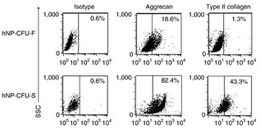椎間板の老化と変性に伴って起こる髄核前駆細胞の消耗
Exhaustion of nucleus pulposus progenitor cells with ageing and degeneration of the intervertebral disc
2012年12月11日 Nature Communications 3 : 1264 doi: 10.1038/ncomms2226

椎間板疾患は非常に広く見られるが、椎間板内の細胞変化や細胞の老化に伴う再生能の変化、また椎間板の変性機序についてはほとんど知られていない。我々は、Tie2陽性(Tie2+)およびジシアロガングリオシド2陽性(GD2+)を示す前駆細胞集団がマウスとヒトの椎間板髄核中に存在することを突き止めた。この細胞は、II型コラーゲンとアグリカンを産生する球状コロニーを形成する。この前駆細胞クローンは多能性で、間葉系へと分化し、NOD/SCID(non-obese diabetic/severe combined immunodeficient)マウスに移植すると髄核組織を誘導し、再構築する。患者組織中のTie2+細胞数を解析すると、加齢や椎間板の変性に伴って顕著に低下し、これは前駆細胞の消耗による再生能低下を示唆している。しかしながら、この前駆細胞(Tie2+GD+)は、単純な培養条件下でその前身の前駆細胞(Tie2+GD-)から誘導可能である。また、Tie2のリガンドの1つであるアンギオポエチン1は髄核細胞の生存に重要である。我々の結果は、椎間板疾患に対する再生治療と新しい診断技術についての手がかりを与えるものである。
酒井 大輔1,2,3, 中村 嘉彦2, 中井 知子1,2, 三島 大志2, 加藤 俊一2, Sibylle Grad4, Mauro Alini4, Makarand V. Risbud5, Danny Chan6, Kathryn S.E. Cheah6, 山村 研一7, 舛田 浩一8, 岡野 栄之9, 安藤 潔2,3 & 持田 譲治1,2,3
- 東海大学医学部 外科学系整形外科学
- 東海大学医学部 再生医学センター、がん幹細胞研究センター
- 東海大学総合医学研究所
- AO Research Institute(スイス)
- トーマス・ジェファーソン大学医学部(米国)
- 香港大学(中国)
- 熊本大学発生医学研究所 個体発生担当
- カリフォルニア大学サンディエゴ校(米国)
- 慶應義塾大学 医学部 生理学教室

